For generations, the Glover family has been selling Christmas trees as part of our family tradition. It is such fun to see the familiar faces light up each year when “the perfect” tree is found. We appreciate the many customers who make coming to Glover Nursery a holiday tradition.
One question we are often asked is “Where do the trees come from?” It’s a great question as the industry has changed significantly from the days of forest harvesting. So, we wanted to share some of what it takes to get the high-quality trees we sell, as they are specifically grown to be enjoyed in your home throughout the holiday season.
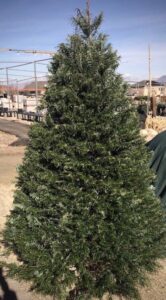 Our Christmas trees are grown on dedicated Christmas tree farms in the Willamette Valley, Oregon which is known for its rich soil and excellent farming communities. On the tree farms, with proper care and maintenance, trees will grow an average of one foot per season. A 6-8-foot tree can take 6 to 10 years before it is ready to harvest. The timeline really depends on yearly growing conditions (i.e. rainfall, temperature, etc).
Our Christmas trees are grown on dedicated Christmas tree farms in the Willamette Valley, Oregon which is known for its rich soil and excellent farming communities. On the tree farms, with proper care and maintenance, trees will grow an average of one foot per season. A 6-8-foot tree can take 6 to 10 years before it is ready to harvest. The timeline really depends on yearly growing conditions (i.e. rainfall, temperature, etc).
However, it takes more than rain to help the trees thrive; they must be pruned to keep the correct shape, fertilized to keep them strong, and monitored to avoid pests or diseases. It’s hard work, but the farmers we work with are the best in the business.
The Search For The Best Trees
Each August, we begin the yearly search to find the most beautiful trees for the upcoming season. Accompanied by our local vendors, we drive from farm to farm looking at quality, color, shape, and variety and taking note of which pass our highly selective appraisal. We make one more trip in the fall to see how the remainder of the growing season progressed and to get a better idea of what sizes and quantities of trees will be available for harvests.
Just as generations before us, we personally select the farms, and often even specific trees, that you see in our lot each season. Because Christmas trees require long-term planning, it is important to visit the farms each year to find our future trees for the next 2 to 5 seasons.
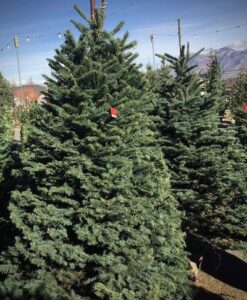 When it’s time to cut the trees, the farmers wrap them up tightly to avoid damaging the beautiful branches they’ve cared for and crafted over the years. Then, they cut them quickly and stack them securely on trucks which are immediately shipped to our store.
When it’s time to cut the trees, the farmers wrap them up tightly to avoid damaging the beautiful branches they’ve cared for and crafted over the years. Then, they cut them quickly and stack them securely on trucks which are immediately shipped to our store.
We unload them, unwrap them, and get them on stands so they are available for sale the day after Thanksgiving, AKA Black Friday! It’s a long process, one that requires dedication and some foresight into what the industry will require years in advance. But, it is also one that brings so much joy to the festive holiday season, we just love being part of it all.
We know some people go back and forth about the pros and cons of real trees and plastic trees, but…
We are firmly on Team Real Christmas Trees. There are so many reasons for this – one being: they smell so darn good! Christmas candles come close, but they just don’t cut it (pun intended).
Real Christmas trees are also beautiful and come in all shapes and sizes. Beyond that, choosing to buy a real Christmas tree has real economic and environmental impacts and it’s all good news!
Real Christmas Trees Are Good For the Economy
Support Local Farmers and Businesses
When you choose a real Christmas tree, you are choosing to support local farmers and businesses instead of big box stores. While 80% of manufactured trees are made in China, 350 million real trees are grown on 15,000 different farms here in the United States. The Christmas tree industry provides approximately 100,000 full-time and part-time jobs every year.
Did You Know? North American Real Christmas Trees are grown in all 50 states!
Land Conservation
As we mentioned before, there are about 15,000 farms growing real Christmas trees and they take up around 350,000 acres which preserve green space.
Christmas trees can grow in soil that is unfit for most other crops. They even enrich the soil and help the biome and nutrient base in the areas where they are grown by pulling out toxins. Plus, for every tree that is chopped down at Christmas time, 1-3 trees are planted in its place for next time! There’s no need to feel like the Lorax when you chop down your Christmas tree.
Did You Know?: There are about 30 million real Christmas trees sold every year in the United States.
Fresh Air
Just one acre of a Christmas tree farm provides enough oxygen for 18 people to breathe, every day. This means that the 350,000 acres provide enough oxygen for 6.3 million people per day. That’s a lot of oxygen! Of course with producing oxygen comes absorbing CO2 and other gasses. One tree alone can absorb 1 ton of CO2 in its lifetime.
Did You Know?: In the 19th century, Americans would cut their trees in nearby forests. Now, Christmas tree farms make the practice more sustainable.
Reduce, Reuse, Recycle
There are over 4,000 programs across the country that help people recycle their real Christmas trees. Of the 25-30 million that are bought each year, 93% of them are recycled through those programs!
Other people opt to buy live trees with their roots still intact so they can plant them in the yard after the holiday festivities are over. Ryan talked about the benefits of purchasing a live tree here.
While real trees are a renewable and recyclable source, artificial trees contain non-biodegradable plastics and even metal toxins. No matter how many times you use the tree, it’s still going to end up in a landfill.
Did You Know?: The carbon footprint of an artificial tree is about 40 kg of C02 compared to a real tree which has a carbon footprint of 3.5 kg-16 kg of C02 depending on how you dispose of it.
Meet The Trees
Our Fresh-Cut Christmas Trees are like flowers in a bouquet—they have been cut off the root ball and will need to be on a tree stand with a water bowl throughout the holidays to keep the needles from drying out.
They cannot be planted after the holidays as they have been cut down and no longer have a root ball. They can be indoors for much longer since they will have the water source from the bowl on the tree stand to keep the cut tree hydrated.
If you chose a Live Christmas Tree it will have the root ball intact so it can be replanted after Christmas. Live trees should only be kept inside for up to five days.
Both of these real Christmas tree options will make for beautiful decor and provide that fresh pine smell that we all love over the holidays.
Which variety will you bring home?
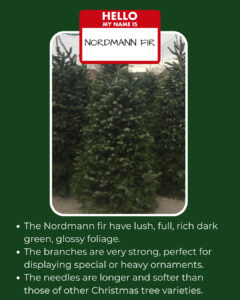 The Nordmann Fir
The Nordmann Fir
The Nordmann fir have lush, full, rich dark green, glossy foliage with needles a little over 1 inch long, and grow from symmetrically arranged branches. The branches are very strong, perfect for displaying special or heavy ornaments. Their needles are longer and softer than those of other Christmas tree varieties.
The Layered Noble
Beautifully layered, Noble firs have a slim profile. The needles turn upward, exposing the lower branches. Known for its beauty, the noble fir is long-lasting, and its stiff branches make it a good tree for heavy ornaments.
The Layered Noble is the tree you think of when you think of a traditional Charlie Brown Christmas Tree. Although, ours are in better shape than poor Charlie’s.
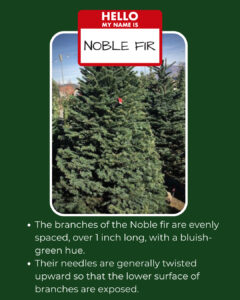 The Noble Fir
The Noble Fir
The branches of the Noble fir are evenly spaced and have needles that are roughly 4-sided (similar to spruce), over 1 inch long, bluish-green and are generally twisted upward so that the lower surface of branches is exposed.
There’s lots of room for ornaments on this tree.
 The Alpine Fir
The Alpine Fir
This is a popular Christmas tree with ornament collectors because of its nicely spaced branches. It’s narrow and tall, resembling a New England church steeple.
The Douglas Fir
Douglas fir has soft needles that are dark green to blue-green in color. When they are crushed, the needles have a sweet fragrance.
This tree is one of the top Christmas tree species in the U.S.
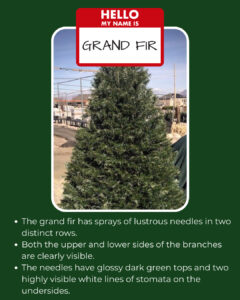 The Grand Fir
The Grand Fir
The Grand fir has sprays of lustrous needles in two distinct rows. Both the upper and lower sides of the branches are clearly visible.
The needles have glossy dark green tops and two highly visible white lines of stomata on the undersides.
How To Care For Your Live Christmas Tree
Live trees and fresh-cut trees each need different types of care and preparation. Here are some of our best tips if you chose to go with a live tree, that you can plant in your yard after Christmas is over, keeping the magical memories alive:
Dig The Hole Early
This is important because if you wait too long and the ground freezes, you won’t be able to plant your tree. Keep track of temperatures and make sure to dig the hole before the first hard freeze.
A tree planting rule of thumb is to dig a hole the depth of the root ball and two times the diameter. If you don’t already know the size of your tree and safe place to start is about 2 feet wide and 1 ½ feet deep. Keep the dug-up dirt in a bucket and make sure to store it somewhere it won’t freeze.
Keep the Rootball Moist
In order to keep your live Christmas tree alive while it is indoors, the root ball must always be kept moist. A tip to keep the root ball moist, but not overwatered, is to display it in a watertight container and use ice cubes that will melt over time.
Have a Transitory Space
Bringing a live tree indoors from the cold and then back outside again in a few days’ time can send it into shock. Before bringing the tree inside (and then again when you bring it back inside) store it in a garage, shed, or sheltered area to allow the tree to get acclimated.
When you are displaying the tree in your home, make sure to keep it away from heat sources and vents as well.
More and more families are choosing a live Christmas tree for their holiday decor. They may require a little extra effort, but it’s a great way to savor the wonderful memories of the holidays every time you see the tree growing in your yard.
How To Care For Your Fresh-Cut Christmas Tree
Here are a few quick tips for keeping your tree in its best possible condition:
- Spray the tree with Wilt-Pruf to preserve freshness (we do this for you at Glover Nursery as part of our service).
- Make a 1/2” fresh cut to the base of the tree to allow the tree to take up water (We will do this part as well).
- Place the tree in water shortly after the cut has been made, ideally no more than 30 minutes.
- Make sure any heating vent near the tree is shut.
- NEVER allow your tree stand to run out of water.
We hope this guide answers all of your Christmas tree questions, but if not, we are always happy to see you here at the nursery and take your calls.
Glover Nursery is your home for Christmas trees if you live in the Salt Lake City Valley. Thank you for making us part of your winter traditions!

